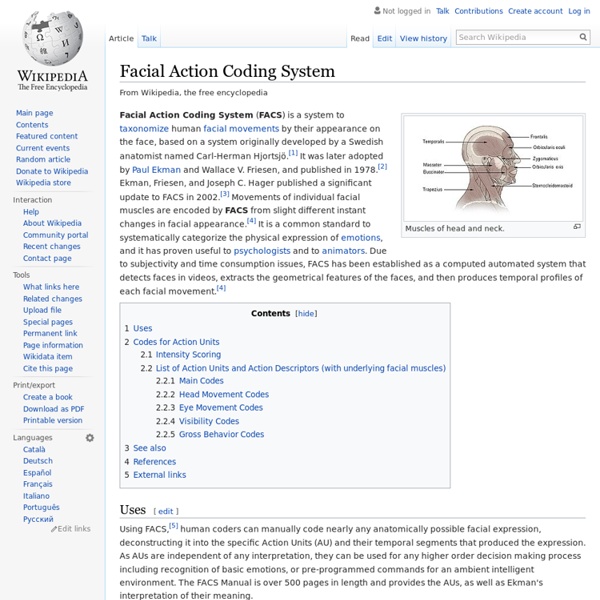



NSF Report - Title Page July 30 to August 1, 1992 Edited byPaul EkmanThomas S. HuangTerrence J. Note: Edited for Web browser presentation 7/97 & 4/00 by J.H.; printed edition 3/93 can be requested from Human Interaction Lab, LPPI Box 0984, University of California, San Francisco, CA 94143. This workshop was supported by the Interactive Systems Program, the Robotics and Machine Intelligence Program, the Social Psychology Program, and the Division of Behavioral and Cognitive Sciences, all entities of the National Science Foundation. Contents I. 5 Ways To Hack Your Brain Into Awesomeness Much of the brain is still mysterious to modern science, possibly because modern science itself is using brains to analyze it. There are probably secrets the brain simply doesn't want us to know. But by no means should that stop us from tinkering around in there, using somewhat questionable and possibly dangerous techniques to make our brains do what we want. We can't vouch for any of these, either their effectiveness or safety. #5. So you just picked up the night shift at your local McDonald's, you have class every morning at 8am and you have no idea how you're going to make it through the day without looking like a guy straight out of Dawn of the Dead, minus the blood... hopefully. "SLEEEEEEEEEP... uh... What if we told you there was a way to sleep for little more than two hours a day, and still feel more refreshed than taking a 12-hour siesta on a bed made entirely out of baby kitten fur? Holy Shit! We're pretty sure Kramer did this once on Seinfeld. How Does It Work? #4. #3. 1. 2. 3.
Mimik & Emotion In einer Vielzahl von Untersuchungen zur Emotionserkennung (Decodierung), sowie zur Emotionsdarstellung (Encodierung), kommt der Mimik, gegenüber anderen Ausdrucksorganen eine besondere Bedeutung zu. Ein wesentlicher Grund hierfür ist, daß die hochdifferenzierte und komplexe Muskulatur des Gesichtes die Darstellung einer großen Zahl unterscheidbarer Gesichtsausdrücke zuläßt. Dabei setzt sich die Gesichtsmimik einer Person aus einer Vielzahl von interagierenden Systemen (z.B. Ein weiterer Grund für die hervorgehobene Stellung der Mimik ist, daß sie auf äußere und innere Reize gegenüber anderen Ausdrucksorganen (z.B. In Untersuchungen zur face-to-face-interaction kommt man weiter zu dem Schluß, daß durch die mimischen Ausdrucksreaktionen sich die Interaktionspartner, oft auch unbewußt, aneinander anpassen und gegenseitig regulieren (Bänninger-Huber & Salisch, 1994). 1.1. 1.2. 1.2.1. 1.2.1.1. Weiter existieren eine Reihe von Ausnahmen, in denen diese Zusammenhangsbeziehung nicht gilt.
Four Things Not To Do To Your Kids Apart from letting them watch Japanese horror movies. John Gottman, from the University of Washington, has a "marriage lab" in which he videotaped/s married couples disagreeing about something minor, in order to study predictors of divorce. He came up with four. You might think they're obvious, but if you actually try to avoid them during an argument, it's harder than you think. It then occurred to me that these often some of the same reasons why some kids "hate" their parents. Disclaimer for the sensitive: the below are inflated examples; these are done to varying degrees, of course, sometimes it's unavoidable, etc, etc. Criticism: The most difficult to avoid. "Did you put away your backpack?" The kid thinks, mom just assumes I do things wrong. It teaches one other awesome message: it doesn't actually matter what I do, only what people think of me. Stonewalling: Stonewalling means: "I am not going to discuss this with you." Defensiveness: NB: this is done by the parent. Kid: you lied to me!
Welcome to ChimpFACS Why Intelligent People Use More Drugs The human consumption of psychoactive drugs , such as marijuana , cocaine , and heroin, is of even more recent historical origin than the human consumption of alcohol or tobacco, so the Hypothesis would predict that more intelligent people use more drugs more frequently than less intelligent individuals. The use of opium dates back to about 5,000 years ago, and the earliest reference to the pharmacological use of cannabis is in a book written in 2737 BC by the Chinese Emperor Shen Nung. Opium and cannabis are the only “natural” (agricultural) psychoactive drugs. Other psychoactive drugs are “chemical” (pharmacological); they require modern chemistry to manufacture, and are therefore of much more recent origin. Morphine was isolated from opium in 1806, cocaine was first manufactured in 1860, and heroin was discovered in 1874. The following graph shows a similar association between childhood intelligence and the latent factor for the consumption of psychoactive drugs among Americans.